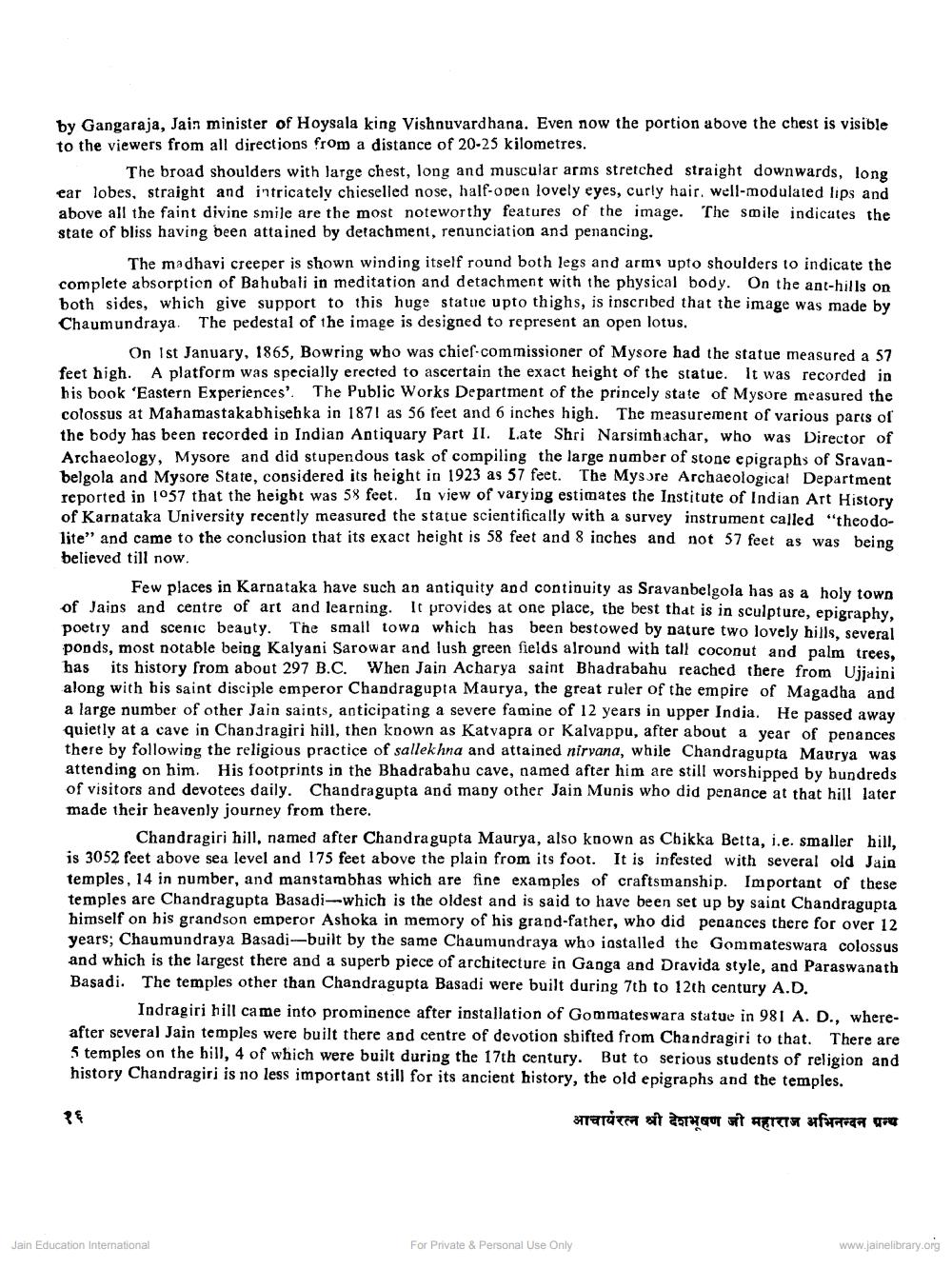________________
by Gangaraja, Jain minister of Hoysala king Vishnuvardhana. Even now the portion above the chest is visible to the viewers from all directions from a distance of 20-25 kilometres.
The broad shoulders with large chest, long and muscular arms stretched straight downwards, long ear lobes, straight and intricately chieselled nose, half-open lovely eyes, curly hair, well-modulated lips and above all the faint divine smile are the most noteworthy features of the image. The smile indicates the state of bliss having been attained by detachment, renunciation and penancing.
The madhavi creeper is shown winding itself round both legs and arms upto shoulders to indicate the complete absorption of Bahubali in meditation and detachment with the physical body. On the ant-hills on both sides, which give support to this huge statue upto thighs, is inscribed that the image was made by Chaumundraya. The pedestal of the image is designed to represent an open lotus.
On 1st January, 1865, Bowring who was chief-commissioner of Mysore had the statue measured a 57 feet high. A platform was specially erected to ascertain the exact height of the statue. It was recorded in his book 'Eastern Experiences. The Public Works Department of the princely state of Mysore measured the colossus at Mahamastakabhisehka in 1871 as 56 feet and 6 inches high. The measurement of various parts of the body has been recorded in Indian Antiquary Part II. Late Shri Narsimhachar, who was Director of Archaeology. Mysore and did stupendous task of compiling the large number of stone epigraphs of Sravanbelgola and Mysore State, considered its height in 1923 as 57 feet. The Mysore Archaeological Department reported in 1957 that the height was 58 feet. In view of varying estimates the Institute of Indian Art History of Karnataka University recently measured the statue scientifically with a survey instrument called "theodolite" and came to the conclusion that its exact height is 58 feet and 8 inches and not 57 feet as was being believed till now.
Few places in Karnataka have such an antiquity and continuity as Sravanbelgola has as a holy town of Jaips and centre of art and learning. It provides at one place, the best that is in sculpture, epigraphy, poetry and scenic beauty. The small town which has been bestowed by nature two lovely hills, several ponds, most notable being Kalyani Sarowar and lush green fields alround with tall coconut and palm trees, has its history from about 297 B.C. When Jain Acharya saint Bhadrabahu reached there from Ujjaini along with his saint disciple emperor Chandragupta Maurya, the great ruler of the empire of Magadha and a large number of other Jain saints, anticipating a severe famine of 12 years in upper India. He passed away quietly at a cave in Chandragiri hill, then known as Katvapra or Kalvappu, after about a year of penances there by following the religious practice of sallekhna and attained nirvana, while Chandragupta Maurya was attending on him. His footprints in the Bhadrabahu cave, named after him are still worshipped by hundreds of visitors and devotees daily. Chandragupta and many other Jain Munis who did penance at that hill later made their heavenly journey from there.
Chandragiri hill, named after Chandragupta Maurya, also known as Chikka Betta, i.e. smaller hill, is 3052 feet above sea level and 175 feet above the plain from its foot. It is infested with several old Jain temples, 14 in number, and manstambhas which are fine examples of craftsmanship. Important of these temples are Chandragupta Basadi--which is the oldest and is said to have been set up by saint Chandragupta himself on his grandson emperor Ashoka in memory of his grand-father, who did penances there for over 12 years; Chaumundraya Basadi-built by the same Chaumundraya who installed the Gommateswara colossus and which is the largest there and a superb piece of architecture in Ganga and Dravida style, and Paraswanath Basadi. The temples other than Chandragupta Basadi were built during 7th to 12th century A.D.
Indragiri hill came into prominence after installation of Gommateswara statue in 981 A. D., whereafter several Jain temples were built there and centre of devotion shifted from Chandragiri to that. There are 5 temples on the hill, 4 of which were built during the 17th century. But to serious students of religion and history Chandragiri is no less important still for its ancient history, the old epigraphs and the temples.
आचार्यरत्न श्री देशभूषण जी महाराज अभिनन्दन अन्य
Jain Education International
For Private & Personal Use Only
www.jainelibrary.org




